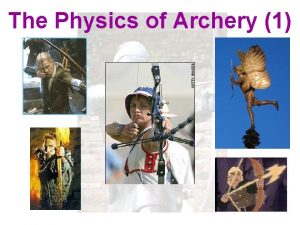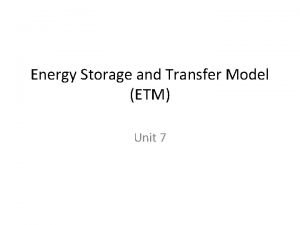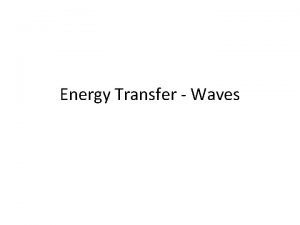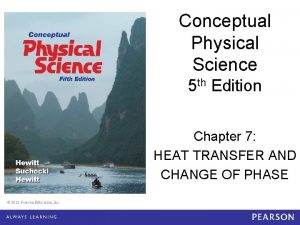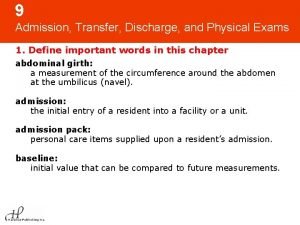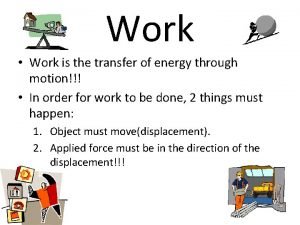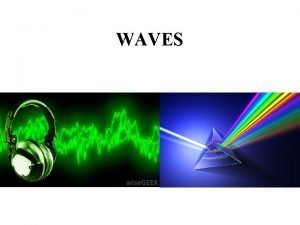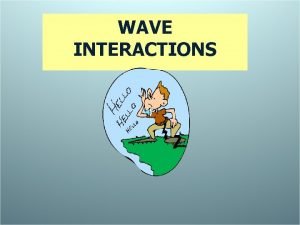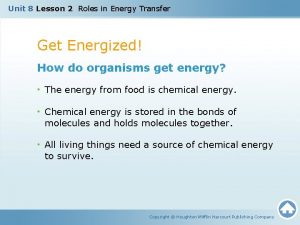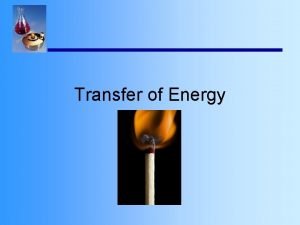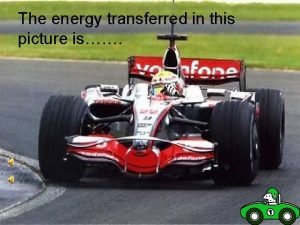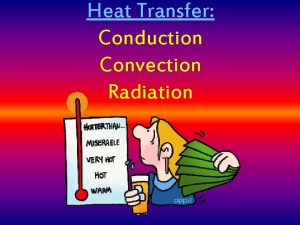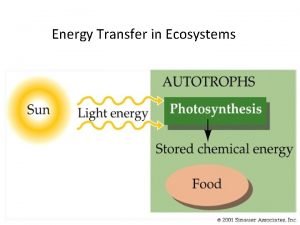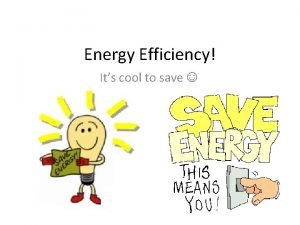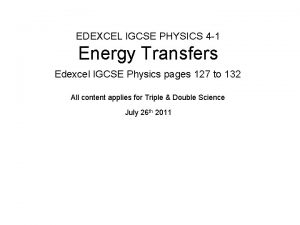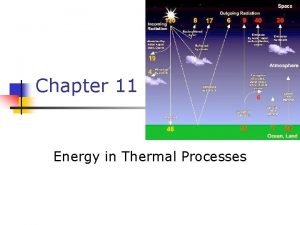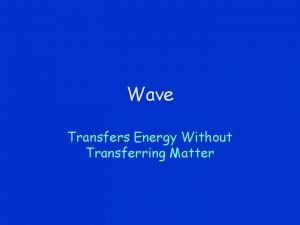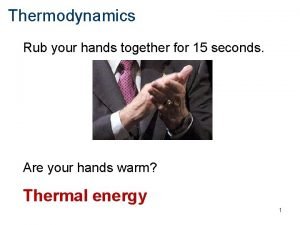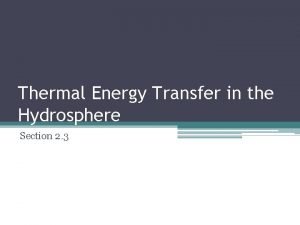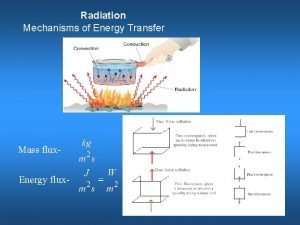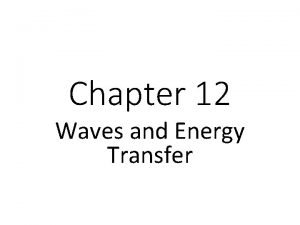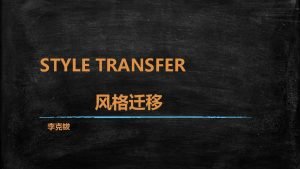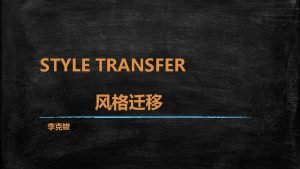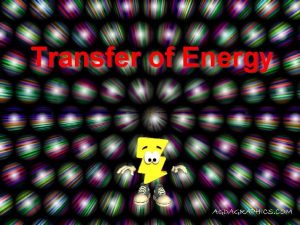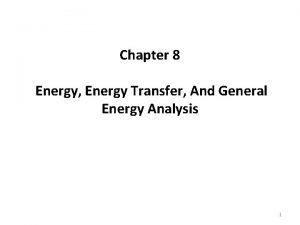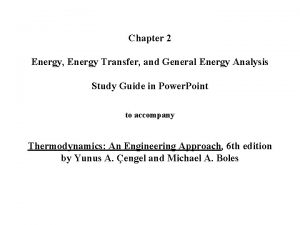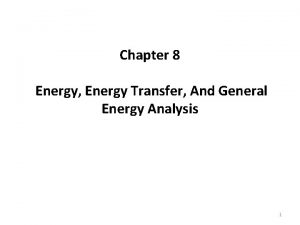Chapter 6 ENERGY AND ENERGY TRANSFER ENERGY IS



































- Slides: 35

Chapter 6 ENERGY AND ENERGY TRANSFER

ENERGY IS CONSERVED Energy is “conserved” meaning it can not be created nor destroyed Can change form Can be transferred Total energy does not change with time.

ENERGY Forms Kinetic Energy Potential Energy Heat Unit: J (Joules) 1 J = 1 Nm = 1 kg m 2 / s 2

MATH: VECTOR DOT PRODUCT

DOT PRODUCT EXAMPLE

DOT PRODUCT EXAMPLE

WORK BY CONSTANT FORCE F WF > 0 s F s WF = 0 F WF < 0 s s F WF > 0 Work means energy transfer.

THE SIGN OF WORK The angle θ between the force and the displacement determines the sign of W.

WEIGHTLIFTER WHEN NOT MOVING

WEIGHTLIFTER WHEN LOWERING

FIND THE WORK DONE BY EACH FORCE θ=2 0º

WORK BY CONSTANT FORCE You pull a chest (of weight 30 N) 5 m across the floor at a constant speed by applying a force of 50 N at an angle of 30°. How much work have you done? Wyou = Fyou s cos θ =(50 N)(5 m)cos 30° = 216. 5 J Fyou = 50 N 30°

WHERE DID THE ENERGY GO? You pull a 30 N chest 5 m across the floor at a constant speed, by applying a force of 50 N at an angle of 30°. How much work did gravity do? How much work did normal force do? How much work did friction do? Fyou = 50 N 30°

WHAT IS THE FRICTION? Fyou = 50 N 30°

SUMMARY Wyou +216. 5 J WG 0 J WN 0 J Wf -216. 5 J Wtotal 0 J

WHERE DID THE ENERGY GO? You spent 216. 5 J of energy pulling. Gravity and normal force absorbed none of the energy. Friction absorbed all 216. 5 J of energy. Negative work done means it absorbs instead of supplying energy.

POSITIVE AND NEGATIVE WORK If W>0, W>0 it means the force gives energy to the object. If W<0, W<0 it means the force absorbs energy from the object.

WHO DOES THE WORK? Make sure when you calculate the work done W, you know which force you are dealing with. In general, different force gives different work. Like in the previous example:

NORMAL FORCE You are towing a car up a hill with constant velocity. The work done on the car by the normal force is: 1. positive 2. negative 3. zero FN V T mg

GRAVITY You are towing a car up a hill with constant velocity. The work done on the car by the gravitational force is: 1. positive 2. negative 3. zero FN V T mg

GRAVITY You are towing a car up a hill with constant velocity. The work done on the car by the gravitational force is: FN V T mg

TENSION You are towing a car up a hill with constant velocity. The work done on the car by the tension force is: FN V 1. positive 2. negative T 3. zero mg

KINETIC ENERGY If I did 100 J of work to push an object of 2 kg on a frictionless surface, what KE does it have in the end? Assume the object was initially at rest. What is the final velocity?

WORK KINETIC ENERGY THEOREM All this says is that the total work we do on an object goes into its KE. Note that this is total work, work not just the work of one of the forces. To calculate Wtotal, you need to find the work of all the forces and add them up.

EXAMPLE Alice and Bob are both pushing a box. Alice does 200 J of work, Bob does -150 J. What is the change in the KE of the box?

WORK BY CONSTANT FORCE You pull a 30 N chest 5 meters across the floor at a constant speed by applying a force of 50 N at an angle of 30 degrees. What is the total work done? 50 N 30

TOTAL WORK You are towing a car up a hill with constant velocity. The total work done on the car by all forces is: 1. positive FN V 2. negative T 3. zero mg

WORK AND POWER A 100 W (=100 J/s) light bulb consumes 100 J of energy per second.

POWER OF A CONSTANT FORCE

WORK & POWER Engine of a jet develops a thrust of 15, 000 N when plane is flying at 300 m/s. What is the power of the engine ?

POWER FOR CIRCULAR MOTION I swing a sling shot over my head. The tension in the rope keeps the shot moving in a circle. How much power must be provided by me, through the rope tension, to keep the v shot in circular motion ? Rope Length = 1 m Shot Mass = 1 kg Angular frequency = 2 rad/s A) 16 J/s B) 8 J/s C) 4 J/s D) 0 J/s

POWER FOR CIRCULAR MOTION Note that the string expends no power, i. e. does no work. Makes sense ? By the work – kinetic energy theorem, work done equals change in kinetic energy. KE = 1/2 mv 2, thus since v does not change, neither does KE. A force perpendicular to the direction of motion does not change speed, v, and does no work.

HORSE POWER AND WATTS Both measures power 1 hp = 746 W

KILOWATT-HOUR AND JOULES Both measure energy 1 k. Wh is the amount of energy dissipated by a 1000 Watts light bulb in one hour. Therefore: 1 k. Wh = (1000 J/s) (3600 s)=3. 6 × 106 J

 Energy energy transfer and general energy analysis
Energy energy transfer and general energy analysis Energy energy transfer and general energy analysis
Energy energy transfer and general energy analysis A disturbance that transfers energy
A disturbance that transfers energy Archery objectives
Archery objectives Energy storage and transfer model test
Energy storage and transfer model test How does energy flow in a food web
How does energy flow in a food web Energy that travels through
Energy that travels through Energy transfer in transverse waves
Energy transfer in transverse waves Chapter 11 admission transfer and discharge
Chapter 11 admission transfer and discharge Chapter 7 heat transfer and change of phase
Chapter 7 heat transfer and change of phase Admission transfer and discharge
Admission transfer and discharge Chapter 9 admission transfer discharge and physical exams
Chapter 9 admission transfer discharge and physical exams Chapter 9 admission transfer discharge and physical exams
Chapter 9 admission transfer discharge and physical exams Work is the transfer of energy
Work is the transfer of energy Work is transfer of energy
Work is transfer of energy Repeating disturbance
Repeating disturbance Waves transfer energy without transferring
Waves transfer energy without transferring Roles in energy transfer
Roles in energy transfer How does conduction transfer heat
How does conduction transfer heat Ecological pyramid of energy
Ecological pyramid of energy Transferred epithet examples
Transferred epithet examples Energy transfer in a torch
Energy transfer in a torch Types of heat transfers
Types of heat transfers Rate of energy transfer by sinusoidal waves on strings
Rate of energy transfer by sinusoidal waves on strings Energy transfer in ecosystems
Energy transfer in ecosystems Energy transfer example
Energy transfer example Energy move
Energy move Microphone energy transfer
Microphone energy transfer Formula for energy transfer
Formula for energy transfer How to calculate percentage energy transfer
How to calculate percentage energy transfer 6 different types of energy
6 different types of energy Energy transfer
Energy transfer A wave transfers
A wave transfers Rubbing your hands together is an example of which transfer
Rubbing your hands together is an example of which transfer Hydrosphere
Hydrosphere Energy transfer
Energy transfer



